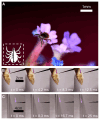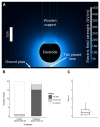Static electricity passively attracts ticks onto hosts
- PMID: 37392744
- PMCID: PMC7616434
- DOI: 10.1016/j.cub.2023.06.021
Static electricity passively attracts ticks onto hosts
Abstract
Most terrestrial animals naturally accumulate electrostatic charges, meaning that they will generate electric forces that interact with other charges in their environment, including those on or within other organisms. However, how this naturally occurring static electricity influences the ecology and life history of organisms remains largely unknown.1 Mammals, birds, and reptiles are known to carry appreciable net electrostatic charges, equivalent to surface potentials on the order of hundreds to tens of thousands of volts.1,2,3,4,5,6,7 Therefore, we hypothesize that their parasites, such as ticks, are passively attracted onto their surfaces by electrostatic forces acting across air gaps. This biophysical mechanism is proposed by us to assist these ectoparasites in making contact with their hosts, increasing their effective "reach" because they are otherwise incapable of jumping. Herein, experimental and theoretical evidence show that the tick Ixodes ricinus (Figure 1A) can close the gap to their hosts using ecologically relevant electric fields. We also find that this electrostatic interaction is not significantly influenced by the polarity of the electric field, revealing that the mechanism of attraction relies upon induction of an electrical polarization within the tick, as opposed to a static charge on its surface. These findings open a new dimension to our understanding of how ticks, and possibly many other terrestrial organisms, find and attach to their hosts or vectors. Furthermore, this discovery may inspire novel solutions for mitigating the notable and often devastating economic, social, and public health impacts of ticks on humans and livestock.8,9,10,11,12,13,14,15.
Keywords: Acari; Ixodes ricinus; charge; ectoparasites; electric ecology; electric fields; electrostatics; parasitism; polarization; triboelectricity.
Copyright © 2023 The Author(s). Published by Elsevier Inc. All rights reserved.
Conflict of interest statement
Declaration of interests The authors declare they have no competing interests.
Figures




References
-
- Byrne WW. Development of an electrostatic discharge model for electronic systems; IEEE International Symposium on Electromagnetic Compatibility; 1982. pp. 199–205. - DOI
-
- Kelly MA, Servais GE, Pfaffenbach TV. An investigation of human body electrostatic discharge. Int Symp Test Fail Anal. 1993;93:167–173.
Publication types
MeSH terms
Grants and funding
LinkOut - more resources
Full Text Sources
Other Literature Sources
Miscellaneous

